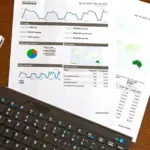What is a canonical tag?
The canonical tag is used when a website has so-called duplicate content. The canonical tag ensures that the website is marked with the leading content and that the page that use it is not indexed by the search engines. It is therefore an essential tool in the field of on-page optimization. The canonical tag is always used in this context when a clear technical URL cannot be displayed, as in the following examples:
The website is accessible with upper and lower case letters (case sensitivity).
http://www.sampleurl.de/basteltipps
http://www.sampleurl.de/BastelTipps
By rewriting the URL, a website can be accessed at two addresses.
The website can also be accessed with tracking parameters:
http://www.sampleurl.de/alleartikel.html
http://www.sampleurl.de/alleartikel.html?tracking_id= 34
On external websites, the same content is
http://www.sampleurl.de/handtuecher
http://www.reinebaumwolle.de/handtuecher
The website can be accessed with or without www.
http://www.sampleurl.de
http://sampleurl.de
The website is accessible with and without trailing slashes.
http://www.sampleurl.de
http://www.sampleurl.de/
The website can be accessed via http and https.
http://www.sampleurl.de
https://www.sampleurl.de
Identical content can be called up in different views (print view, PDF) with different URLs.
Websites can also be reached with session IDs:
http://www.sampleurl.de/alleartikel.html
http://www.sampleurl.de/alleartikel.html ?session_id=56
The website can be accessed with the index file shown or without it.
http://www.sampleurl.de/
http://www.sampleurl.de/index.php
Integration
In order to integrate the canonical tag into a website in a targeted manner, the attribute rel=”canonical” should be found in the HEAD area of the canonical website.
<!DOCTYPE> <html> <head> … <link rel=”canonical” href=”https://www.ihre-ziel-url.de” /> … </head> <body>…</body> </html>
Some content management systems, such as WordPress, have their own plug-ins for this requirement in order to implement the canonical links in a targeted manner.
Canonical tag in the application
PAGINATION: When it comes to pagination, subsequent pages in the blog area are often marked with next or previous. In the context of pagination, the use of canonical tags makes no sense unless there is duplicate content in the blog area.
HREFLANG: In the case of language variables, there is at least thematic duplicate content. However, texts that have the same content but are written in different languages are not considered duplicate content. In this context, the use makes little sense.
Noindex: If a website is set to noindex, the webmaster wants it to be excluded from indexing. If a link is now made to this instance using a canonical tag, a contradiction occurs, and the search engine does not evaluate the link.
DUPLICATE CONTENT: If a page has duplicate content, the canonical tag is used. It links from the page that should not appear in the search index to the target page that should be included in the search engine index using a canonical tag set in the head area. However, it is important that duplicate content actually exist.
Common mistakes when using the canonical tag
The canonical tag is a powerful tool, and mistakes can quickly lead to losses in search engine positions. With that in mind, we’ve rounded up the most common mistakes made when using canonical tags:
404 Error Pages: Canonical tags should only link to pages that actually exist. If a canonical tag triggers a 404 status code, it is not conducive to search engine rankings.
Noindex, Nofollow, Disallow: The canonical tag should not be used in conjunction with other search engine robot tags. This could lead to misinterpretations by the search engine.
Position: The canonical tag should always be in the head area of a website, is not intended to be placed in the body area.
Relative URL information: Links in the canonical tag should always be absolute. Relative links can lead to errors, which are reflected in poor rankings.
Canonical tag alternative
If it is technically possible, canonical tags should be avoided, and websites should be redirected statically via 301 redirects. Then the search engine has the best chance of indexing the relevant content.
Conclusion on Canonical Day
The Canonical Tag is an important tool for webmasters and corporate SEOs. The targeted use ensures a better understanding of the website on the part of the search engine and can help get problems with duplicate content under control. We would be happy to support you as an SEO agency in the target-oriented optimization of your website .





